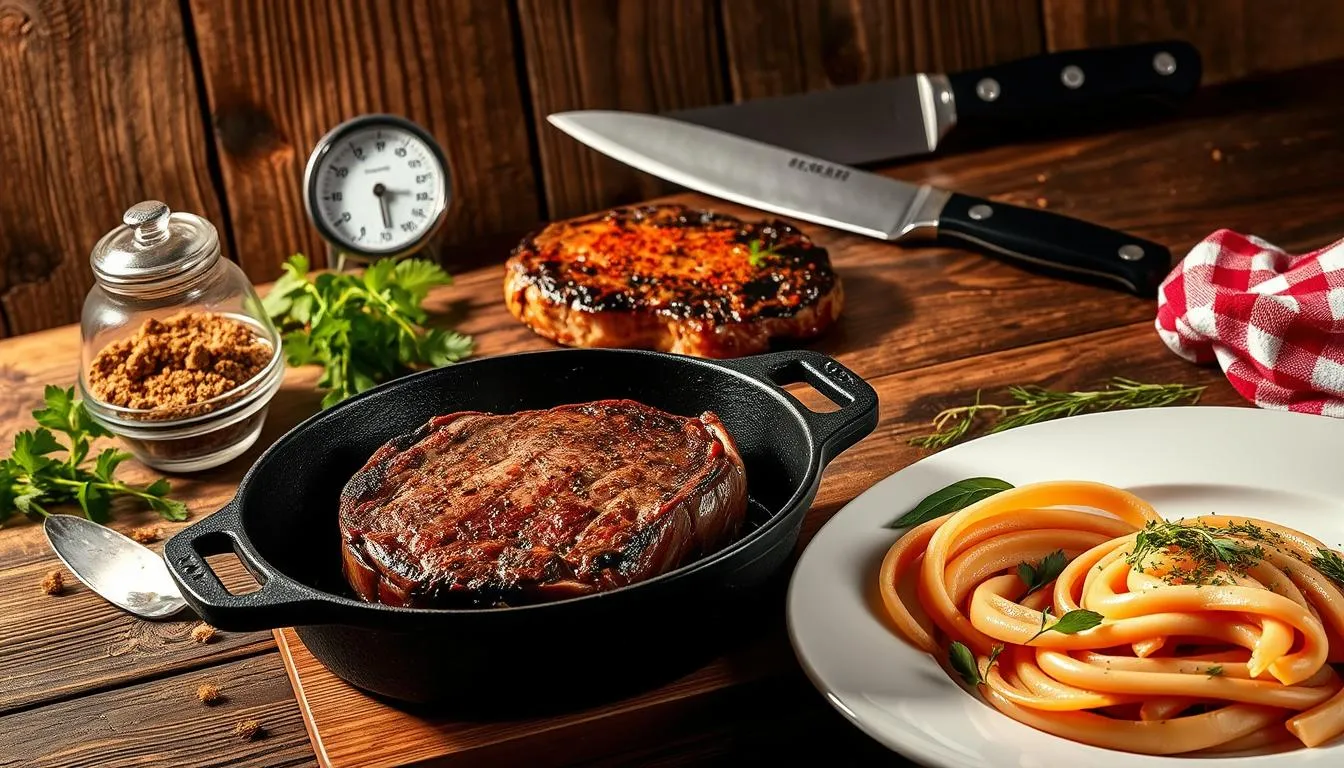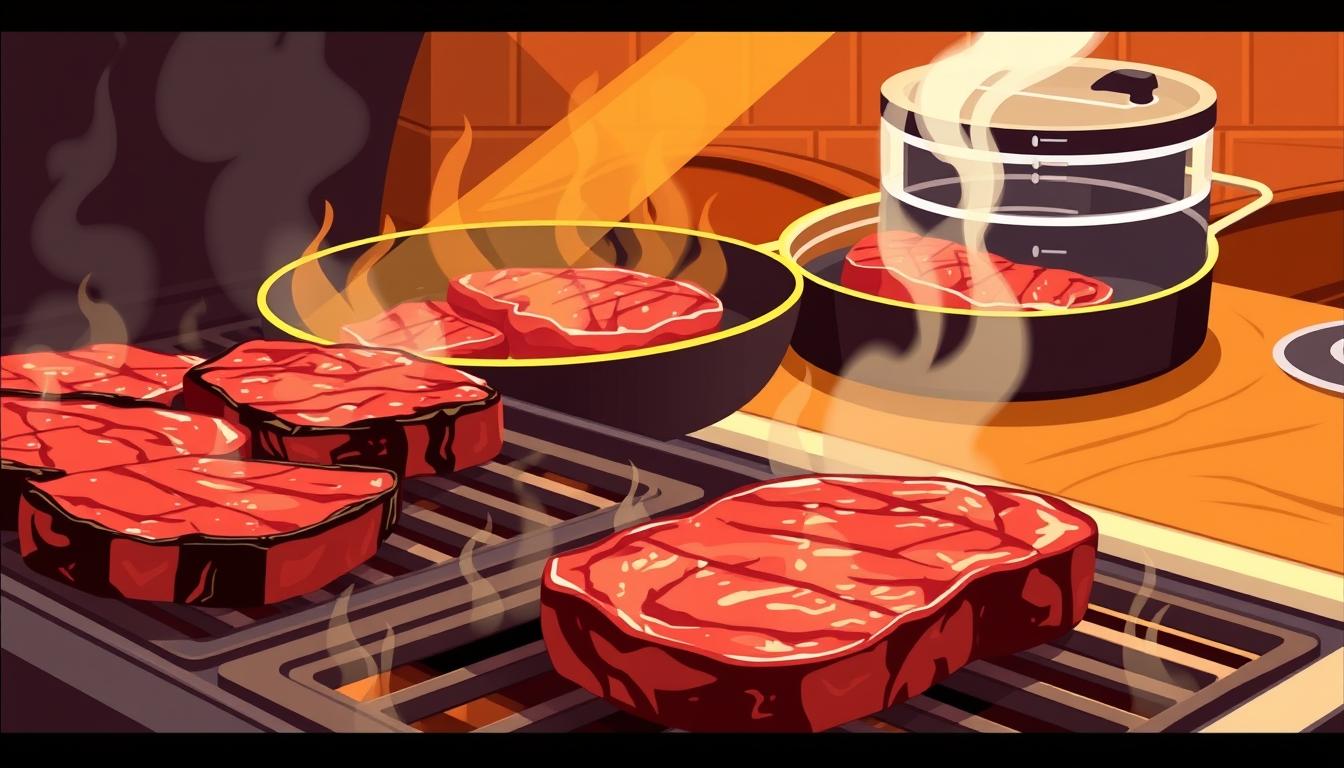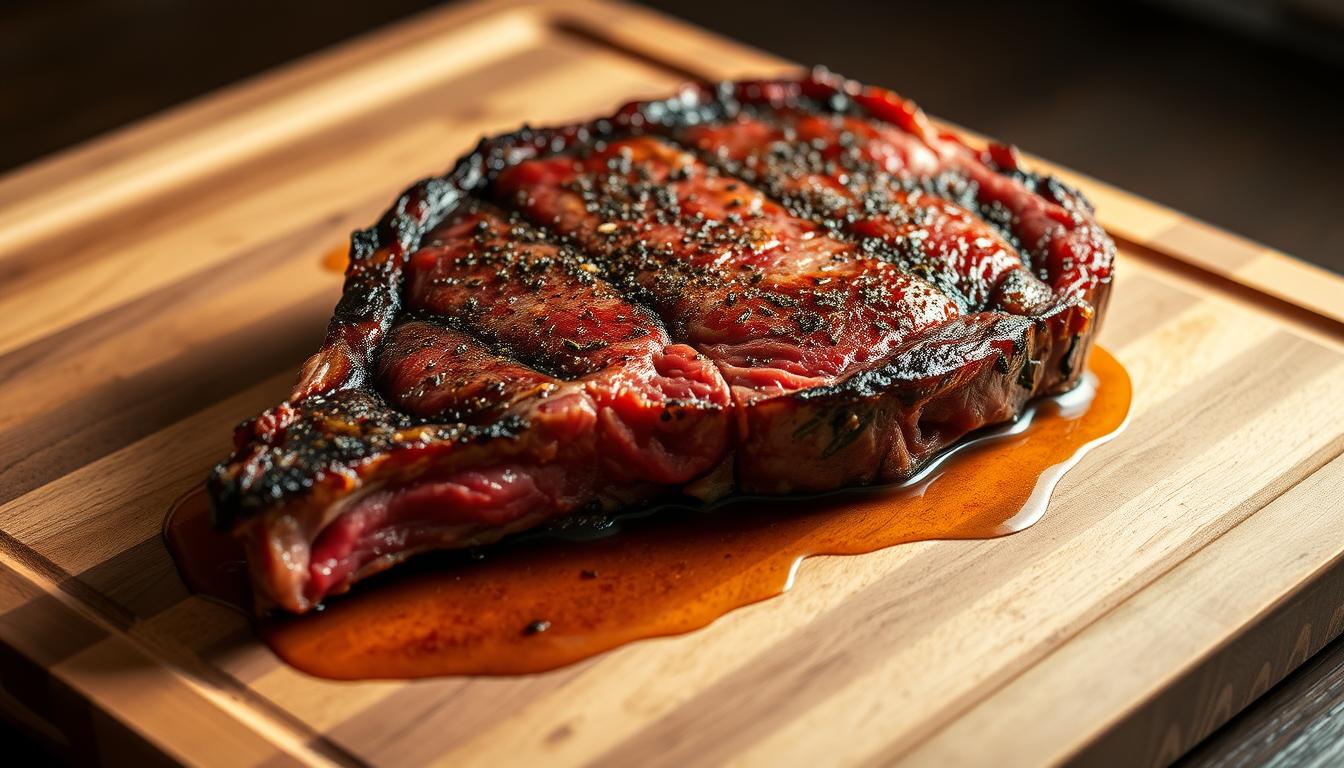How to Cook the Perfect 14 oz Steak at Home 2025

How to Cook the Perfect 14 oz Steak at Home 2025
Table of Contents

Every home cook dreams of making a 14 oz steak that’s perfect. I remember my first time making a steak into a masterpiece. The smell, the crust, and the tender meat were amazing.
Cooking a perfect 14 oz steak is more than just technique. It’s about passion, precision, and knowing how to prepare meat.
This guide is for anyone who wants to cook steak like a pro. You’ll learn how to pick the right cut and master cooking techniques. You’ll find out how to make a great steak into an unforgettable meal.
We’ll use tips from beefsalami.com and years of cooking experience. We’ll make steak preparation easy and simple. Get ready to wow your family and friends with your steak-cooking skills.
Ingredients :
- 1 (14 oz) ribeye steak, about 1 to 1¼ inches thick
- 1 tablespoon olive oil
- 1 teaspoon kosher salt
- ½ teaspoon freshly ground black pepper
- ½ teaspoon garlic powder
Garlic Butter:
- 2 tablespoons unsalted butter, softened
- 1 clove garlic, minced
- 1 tablespoon fresh parsley, chopped
- Pinch of salt
Directions:
- Remove the steak from the refrigerator and let it come to room temperature for about 30 minutes.
- In a small bowl, combine the garlic butter ingredients: softened butter, minced garlic, chopped parsley, and a pinch of salt. Mix well and set aside.
- Preheat a grill or grill pan over high heat. Pat the steak dry with paper towels.
- Brush both sides of the steak with olive oil, then season evenly with salt, pepper, and garlic powder.
- Place the steak on the hot grill and cook for 4–5 minutes per side for medium-rare, or until it reaches your desired doneness. Use a meat thermometer for accuracy (130–135°F for medium-rare).
- Remove the steak from the grill and immediately top it with the garlic butter. Let it rest for 5 minutes before slicing.
Prep Time: 5 minutes
Cooking Time: 10 minutes
Servings: 1
Calories: 710 per serving
Nutritional Information (per serving):
Calories: 710
Protein: 55g
Fat: 53g
Carbohydrates: 2g
Key Takeaways
- Master the art of selecting the perfect 14 oz steak
- Learn professional cooking techniques for restaurant-quality results
- Understand the importance of meat selection and preparation
- Discover temperature and seasoning secrets
- Transform your home cooking with expert steak preparation methods
Understanding Different Types of 14 oz Steak Cuts
Choosing the right steak can make your meal special. Each cut has its own taste, tenderness, and feel. Knowing about different steaks helps you pick the best for your next meal.
Premium Cuts: Ribeye vs Porterhouse
Ribeye and porterhouse are top choices for prime steak. Ribeye is loved for its marbling and flavor. Its fat makes it juicy and tender.
Porterhouse is special because it has tenderloin and strip steak together. It gives you two tastes and textures in one piece:
- Tenderloin side: Soft and lean
- Strip side: Rich and flavorful
Lesser-Known Yet Flavorful Options
There are many other steaks that taste great and are good value. If you like trying new things, consider:
- Flat iron steak
- Tri-tip
- Hanger steak
USDA Grading and Quality Indicators
USDA grading shows the meat’s quality. Prime is the best, with lots of marbling and tenderness. Here’s a quick guide to steak quality:
| Grade | Marbling | Tenderness |
|---|---|---|
| Prime | Abundant | Excellent |
| Choice | Moderate | Very Good |
| Select | Minimal | Good |
“The secret to a great steak is not just in the cut, but in understanding its unique characteristics.” – Professional Chef
Essential Equipment for Cooking Restaurant-Quality Steak
To turn your kitchen into a steak lover’s dream, you need the right tools. Professional chefs say quality equipment is key to making a juicy steak. It’s as good as what you find in restaurants.
Here are the must-haves for your steak cooking kit:
- Cast Iron Skillet: The ultimate heat conductor for perfect searing
- Meat Thermometer: Ensures precise internal temperature
- Long-handled Tongs: For safe and precise meat handling
- Heavy-duty Cutting Board: Provides stable surface for preparation
- Sharp Chef’s Knife: Essential for trimming and cutting
High-quality cooking tools make a big difference. A good meat thermometer prevents overcooking. A cast iron skillet gives you that golden-brown crust everyone loves.
Professional chefs suggest using digital instant-read thermometers. They give you the most accurate temperature readings. This is crucial when cooking steak. It helps you get the perfect doneness, from rare to well-done.
“Great equipment transforms an average cook into a steak master.” – Professional Chef Recommendation
The right tools make cooking easier and better. With these essentials, you’ll be able to make a juicy steak that wows everyone.
Selecting the Perfect 14 oz Steak at Your Local Butcher
Choosing the right beef steak is more than picking a random cut. Your search for the perfect 14 oz rib eye steak begins with knowing what to look for. Understanding key selection criteria helps you find exceptional meat.
Before you go to the butcher, learn what makes a steak stand out. Look for visual cues and listen to expert advice. This will help you make a smart choice.
Marbling Patterns to Look For
When picking a 14 oz rib eye steak, pay attention to marbling. This is the white fat streaks in the meat. High-quality steaks have:
- Consistent, fine white fat distribution
- Intricate web-like fat patterns
- Fat that appears white or creamy, not yellow
Age and Color Indicators
Fresh beef steak shows its quality through color and look. Look for:
- Color: Bright cherry-red meat suggests freshness
- Consistent coloration without dark spots
- Firm texture with minimal moisture
Price vs Quality Considerations
While cost is important, spending more on a high-quality 14 oz rib eye steak is worth it. Here’s what to keep in mind:
- Prime-grade cuts cost more but offer superior marbling
- Choice-grade steaks provide good value
- Select cuts are more budget-friendly but less tender
Your local butcher can help you find the best beef steak. They’ll consider your taste and budget.
Proper Steak Storage and Temperature Guidelines
Storing your 14 oz ribeye right is key to keeping its quality and taste. Knowing the best storage methods helps keep the meat’s texture good. It also prevents food safety problems.
Knowing how big your 14 oz steak is helps pick the best storage method. Keeping it in the fridge at the right temperature is essential. This keeps your steak fresh and tasty.
- Refrigerate fresh steaks at 40°F or below
- Store unwrapped steaks in the coldest part of the refrigerator
- Use original packaging or wrap tightly in butcher paper
- Consume refrigerated steaks within 3-5 days
Freezing your 14 oz ribeye needs careful steps to keep it good. Wrap the steak tightly in freezer paper or vacuum-sealed bags. This stops freezer burn.
| Storage Method | Maximum Storage Time | Recommended Temperature |
|---|---|---|
| Refrigerator | 3-5 days | Below 40°F |
| Freezer | 6-12 months | 0°F or below |
“The key to preserving your steak’s quality is protecting it from air exposure and maintaining consistent, cold temperatures.” – Professional Chef
When thawing your steak, always use the fridge method. Never let a 14 oz ribeye sit at room temperature for more than two hours. Slow thawing keeps the meat’s texture and stops bacteria growth.
Pro tip: Place the frozen steak on a plate in the refrigerator and allow 24 hours of thawing time for every 4-5 pounds of meat.
The Science Behind Meat Tenderization Methods
Turning a tough 14 oz rib eye into a tender treat needs a grasp of meat tenderization science. Various methods can soften muscle fibers, enhancing your sirloin steak’s tenderness and taste.
Meat tenderization is complex, aiming to break down proteins and connective tissues. By using certain techniques, you can significantly enhance your steak’s texture and flavor.
Dry Aging Process
Dry aging is a high-end method, often used for premium cuts like the 14 oz rib eye. Meat is kept in a controlled space with precise humidity and temperature. This process uses enzymes to soften muscle fibers, enriching the meat’s flavor.
- Enhances meat tenderness
- Develops deeper flavor profiles
- Typically takes 14-28 days
Marinades and Their Effects
Marinades soften meat fibers with acidic ingredients. When preparing a sirloin steak, marinades infuse flavor and soften the meat.
- Acidic ingredients like vinegar or citrus juice
- Enzymatic ingredients such as pineapple or papaya
- Oil-based marinades for moisture retention
Mechanical Tenderizing Techniques
Physical methods can also soften tough muscle fibers. Techniques like pounding, scoring, or using a meat mallet create tiny tears. This makes your steak more tender.
Each tenderization method has its own benefits. They help turn even the toughest cuts into delicious meals.
Seasoning Techniques for Maximum Flavor
Turning a regular beef steak into a juicy masterpiece starts with the right seasoning. The right seasoning can make your meat go from good to amazing. It unlocks flavors that make your taste buds dance.
Salt is key for great beef steak seasoning. Chefs say kosher or sea salt works best. Season generously but smartly:
- Apply salt 30-45 minutes before cooking
- Use coarse-grain salt for better distribution
- Create a light crust that enhances natural meat flavors
Don’t just stop at salt and pepper. Try world-class seasoning techniques for more flavor:
- Classic steak rub with paprika and garlic powder
- Herbs de Provence blend for European flair
- Smoky Southwest-inspired mix with chili powder
The secret to perfect seasoning is balance. You want to boost the beef’s taste, not hide it. Try different mixes, but always let the meat’s quality stand out.
Pro tip: Pat your steak dry before seasoning to ensure maximum flavor absorption and a perfect crust.
Seasoning is an art. Each steak is different, and finding your perfect mix takes time and effort.
Preparing Your 14 oz Steak for Cooking
Getting a 14 oz steak ready for cooking needs careful steps before it hits the pan or grill. The right prep can turn a simple cut into a top-notch meal. Cooking steak is more than just heating it up; it’s an art that starts long before.
Experts say the key to great steak prep is in the details. You aim to make the most delicious, perfectly cooked 14 oz steak.
Room Temperature Principles
It’s important to let your 14 oz steak come to room temperature before cooking. Cold meat cooks unevenly, leading to tough spots. Here’s how to do it right:
- Take the steak out of the fridge 30-45 minutes before cooking
- Put it on a clean plate or cutting board
- Avoid direct sunlight or heat
- Loosely cover with a paper towel to keep it dry
Pat-Dry Technique
Moisture ruins a perfect sear on steak. A dry steak gets a crispy crust that keeps flavors in.
- Use paper towels to dry the steak all over
- Make sure it’s dry before seasoning
Pre-Seasoning Strategy
Seasoning your 14 oz steak is all about timing. Salt works differently at different times. Here’s the best way to season:
- Salt the steak 40 minutes before cooking for deep flavor
- Use kosher or sea salt for the best taste
- Grind black pepper just before cooking
- Avoid salting more than an hour ahead to prevent drying out
Learning these prep steps will make your steak amazing. It’ll ensure a memorable meal every time you cook.
Different Cooking Methods for Perfect Results

Learning to cook a perfect grilled steak is all about mastering different cooking techniques. Each method brings out unique flavors and textures in various cuts. This is especially true for a premium new york strip steak.
Here are the most popular cooking methods for achieving restaurant-quality results:
- Grilling: The classic method for creating a smoky, charred exterior
- Pan-Searing: Perfect for developing a rich, golden-brown crust
- Oven-Roasting: Ideal for even cooking and maintaining moisture
- Sous-Vide: Precise temperature control for consistent doneness
Your choice of cooking method depends on several factors:
- Cut of meat (thickness matters)
- Available kitchen equipment
- Desired level of doneness
- Flavor profile you want to achieve
For a new york strip steak, pan-searing or grilling often yields the best results. These methods help lock in juices while creating a delectable exterior crust that steak enthusiasts crave.
Pro tip: Regardless of the cooking method, always let your steak rest after cooking to redistribute internal juices.
Experimenting with different techniques will help you discover your preferred way of preparing a mouth-watering grilled steak. This will impress your family and friends.
Pan-Searing Secrets for a Perfect Crust
Learning to pan-sear can make your 14 oz ribeye amazing. It’s all about precision to get that golden crust. This crust locks in flavor and makes the meat richer.
To get a great pan-sear, you need to manage heat well and pick the right oil. Your aim is to get a beautiful crust while keeping the steak juicy inside.
Heat Control Techniques
Controlling heat is key when pan-searing a steak. Here are some important tips:
- Preheat your cast-iron skillet until it’s smoking hot
- Use medium-high heat to prevent burning
- Allow 2-3 minutes of cooking per side for a 14 oz ribeye
- Rotate the pan to ensure even heat distribution
Oil Selection Guide
Choosing the right oil matters for flavor and 14 oz ribeye calories. Here are some great options:
- Avocado oil: High smoke point, neutral flavor
- Grapeseed oil: Light taste, excellent for searing
- Clarified butter: Rich flavor, higher smoke point
Pro tip: Always pat your steak dry before searing. This helps get a crisp crust and keeps the inside juicy.
Grilling Your Steak to Perfection
Grilling a juicy steak is all about precision and technique. With the right approach, your steak can go from ordinary to extraordinary. The secret lies in managing heat and creating the perfect cooking environment.
Begin by setting up your grill with different heat zones. This lets you control the temperature and avoid burning your steak. For gas grills, use one side for high heat and the other for medium. Charcoal grills need careful coal placement for direct and indirect heat.
- Preheat the grill to 450-500°F for optimal searing
- Clean and oil grill grates to prevent sticking
- Use tongs instead of a fork to avoid piercing the meat
To get beautiful grill marks, place the steak at a 45-degree angle to the grates. Then, rotate it halfway through cooking each side. This technique creates those impressive crosshatch marks.
Be careful of flare-ups, as they can quickly char your steak. Keep a spray bottle of water ready to control flames. Aim for a steak with a crisp outside and a tender, moist inside.
Pro tip: Let your steak rest for 5-10 minutes after grilling to redistribute internal juices.
Different grills offer unique benefits. Gas grills offer consistent heat, while charcoal grills add a smoky flavor. Choose the method that fits your cooking style and taste.
Using a Meat Thermometer Correctly
Cooking steak to perfection needs precision, and a meat thermometer is key. It helps you get the perfect 14 oz ribeye protein doneness. Learning how to use it right can make your cooking as good as a restaurant’s.
Getting the temperature right is vital for a 14 oz ribeye. The right method means you’ll never serve a steak that’s too raw or too cooked again.
Temperature Ranges for Doneness
Different doneness levels need specific internal temperatures:
- Rare: 125°F (52°C)
- Medium-Rare: 135°F (57°C)
- Medium: 145°F (63°C)
- Medium-Well: 150°F (66°C)
- Well-Done: 160°F (71°C)
Proper Probe Placement Techniques
Here’s how to use a meat thermometer for steak:
- Put the probe in the thickest part of the steak
- Don’t touch fat or bone for accurate readings
- Make sure the thermometer tip is in the center of the meat
- Wait 10-15 seconds for a steady temperature
Knowing how protein changes when cooking is important. As the 14 oz ribeye heats up, its structure changes. This affects its tenderness and taste. By using a meat thermometer correctly, you’ll always get the perfect steak.
Resting Your Steak: Timing and Technique

Learning to rest your 14 oz rib eye is key for a juicy steak. After cooking, the steak needs time to spread out its juices. This makes it taste better and feel softer.
The resting time lets the muscle fibers relax and soak up juices. These juices were pushed to the center by the heat. This simple trick can make any steak taste like it’s from a fancy restaurant.
- Recommended resting times based on steak thickness:
- Thin cuts (1/2 inch): 3-5 minutes
- Medium cuts (1 inch): 5-7 minutes
- Thick cuts like 14 oz rib eye: 8-10 minutes
To rest your steak right, follow these steps:
- Remove the steak from heat source
- Place on a clean cutting board or warm plate
- Loosely tent with aluminum foil
- Keep in a warm area away from direct drafts
While resting, the steak’s temperature will go up a bit. This finishes the cooking. Your 14 oz rib eye will be tender and juicy, with great flavor in every bite.
Complementary Sauces and Compound Butters
Turning a good beef steak into an amazing one often depends on the right sauce or compound butter. Prime steak needs top-notch sides that boost its rich taste and soft texture.
Classic steak sauces can make your meal unforgettable. Here are some top picks for your prime steak:
- Béarnaise Sauce: A creamy, herb-infused classic
- Peppercorn Sauce: Spicy and robust
- Red Wine Reduction: Elegant and deeply flavored
Compound butters are another tasty way to enhance your beef steak. These butter mixes add instant richness and depth to your dish.
| Compound Butter Flavor | Key Ingredients | Best Paired With |
|---|---|---|
| Garlic Herb Butter | Garlic, parsley, thyme | Grilled ribeye |
| Blue Cheese Butter | Blue cheese, chives | Pan-seared tenderloin |
| Chipotle Lime Butter | Chipotle peppers, lime zest | Spicy prime steak cuts |
Pro tip: Always let your compound butter soften at room temperature before serving. Let it melt slightly over a hot beef steak for the best flavor.
“A great sauce can turn a good steak into an unforgettable meal.” – Professional Chef
Try different mixes to find your favorite steak side. The right sauce or butter can make your prime steak a memorable meal.
Wine Pairing Suggestions for Your Steak Dinner
Finding the perfect drink to go with your steak can make your meal unforgettable. The right wine or drink brings out the best in your steak. It makes every bite a special moment.
When picking a wine for your steak, think about the steak’s type. A bold ribeye steak goes well with full-bodied red wines. These wines match its strong taste.
Red Wine Selections
The right wine depends on the steak cut and how it’s cooked. Here are some top red wine picks:
- Cabernet Sauvignon: Great for fatty porterhouse steaks
- Malbec: Enhances grilled ribeye steak’s bold taste
- Syrah/Shiraz: Good with pepper-crusted steaks
Alternative Beverage Pairings
Not everyone likes wine with their steak. Here are some other drinks that pair well:
- Craft beer with strong flavors
- Single malt whiskey
- Craft cocktails with smoky notes
- Non-alcoholic options like sparkling water with citrus
Try different drinks to find your favorite. It’s a fun way to enjoy your steak even more.
Common Steak Cooking Mistakes to Avoid
Mastering steak cooking means knowing what to avoid. Simple mistakes can turn a great steak into a disaster. Home cooks often struggle to get a juicy steak because of these errors.
- Overcooking: The main reason for dry, tough meat is cooking it too long. Use a meat thermometer for the right temperature.
- Skipping the Rest Period: Cutting into a steak right after cooking lets juices escape. This makes the steak less juicy.
- Incorrect Seasoning: Not enough seasoning or the wrong salt can mess up the flavor and texture.
Temperature control is key when cooking steak. Start by letting your steak come to room temperature. This ensures even heat and prevents burning the outside before the inside is cooked.
Choosing the wrong cooking method is another big mistake. Not every steak is the same. Thicker cuts like ribeye need different methods than thinner steaks to stay juicy.
Pro tip: Always pat your steak dry before cooking. This helps get a perfect sear and keeps the juices in.
Knowing these common mistakes will help you make great steaks at home. With practice, patience, and attention to detail, you’ll get better at cooking steak.
Conclusion
Cooking a perfect 14 oz steak at home is an art. It mixes technique, passion, and practice. You’ve learned key skills, from picking top cuts to mastering cooking methods. These skills turn simple meat into a top-notch meal.
Your steak cooking journey is just starting. Every time you cook a 14 oz steak, you’ll learn more and get better. Great cooking needs patience, focus, and a love for trying new things.
For more tips and ideas, check out beefsalami.com. It’s your go-to for steak cooking advice. Whether you’re new or experienced, our guides will boost your cooking skills. You’ll make steak dishes that wow everyone.
Keep exploring and stay curious about steak cooking. Your path to becoming a 14 oz steak master begins today!
FAQ
How big is a 14 oz steak?
A 14 oz steak is about 1 inch thick. It usually covers most of a dinner plate. This size is perfect for one person, offering a big and tasty meal.
What are the nutritional highlights of a 14 oz ribeye?
A 14 oz ribeye has around 840-980 calories and 70-80 grams of protein. It’s full of iron, zinc, and vitamin B12. Its high protein and marbling make it flavorful and tender.
What’s the best way to cook a 14 oz ribeye steak?
For the best taste, pan-sear then oven-finish. First, let the steak warm up. Season it well with salt and pepper. Sear in a hot skillet for 3-4 minutes each side. Then, bake at 400°F for 5-7 minutes to get it just right.
How long should I let my steak rest after cooking?
Let a 14 oz steak rest for 5-10 minutes. This lets the juices spread, making it tender and juicy. Cover it with foil to keep it warm.
What’s the difference between a ribeye and a porterhouse steak?
A ribeye comes from the rib section, known for its marbling and flavor. A porterhouse has tenderloin and strip steak, separated by a bone. Ribeyes are more marbled and flavorful than porterhouses.
How can I tell if my steak is cooked to the right temperature?
Use a meat thermometer for the best results. For medium-rare, aim for 130-135°F. Insert the thermometer into the thickest part, avoiding fat or bone. The temperature will rise a bit during resting, so remove it slightly before your desired doneness.
What are the best seasonings for a ribeye steak?
Classic choices are salt and black pepper. You can also try garlic powder, rosemary, thyme, or a steak rub. Use coarse sea salt or kosher salt and freshly ground black pepper to enhance the beef’s natural flavors.
How should I store my steak before cooking?
Keep your steak in the coldest part of the fridge, on a plate to catch drips. Wrap it loosely in its original packaging or butcher paper. Cook it within 3-5 days or freeze for 4-6 months.
